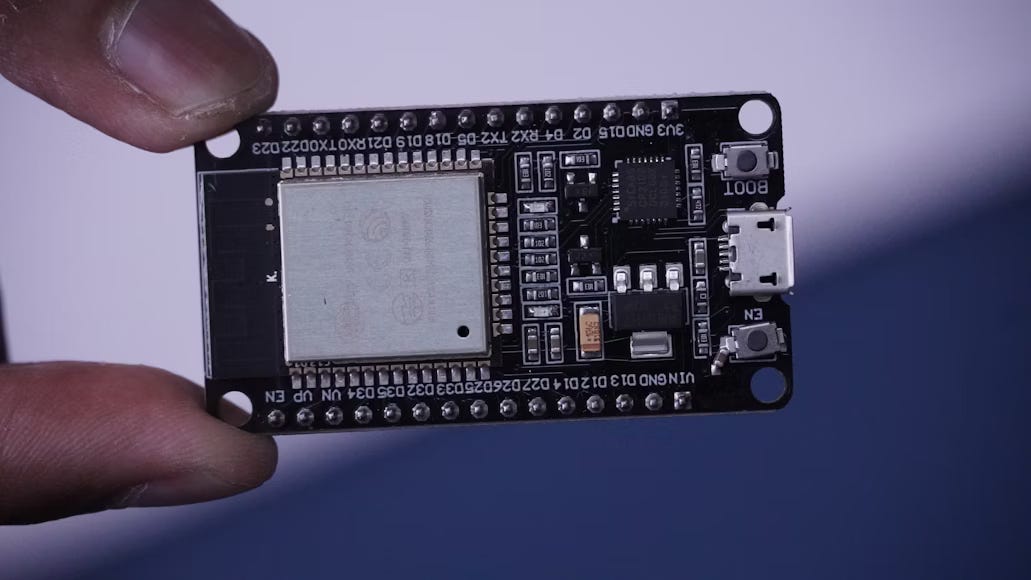The Sulking Robot: Wi-Fi Problems in ESP32 Systems

The ESP32 microcontroller powers countless IoT devices. Engineers love it for its compact size, low power use, and built-in Wi-Fi. You'll find it in wearables, home sensors, and robots. But the ESP32 has a problem. Its wireless connection fails at the worst times.
Robots built with ESP32 chips suddenly stop responding. They seem to sulk or ignore commands. The issue isn't bad code or faulty programming. The wireless system itself breaks down in real-world conditions.
How ESP32 Connects and Fails
The ESP32 uses IEEE 802.11 protocols in the 2.4 GHz band. This frequency range is crowded. Microwaves, Bluetooth devices, and dozens of routers all compete for the same airspace. Interference is constant.
Physical barriers make things worse. Walls, metal furniture, and moving people block signals. The ESP32's weak radio signal gets lost in the chaos.
Power-saving features add more problems. The chip enters deep sleep mode to save battery. Waking up takes time. The ESP32 needs up to 500 milliseconds to reconnect to Wi-Fi. Robots that expect instant responses get confused during these delays.
The Numbers Behind the Problems
Three measurements explain why ESP32 robots act strangely:
Signal Strength (RSSI) measures incoming signal power. The ESP32 becomes unstable below -80 dBm. At -85 dBm, connections drop regularly.
Packet Error Rate (PER) shows how many data packets fail. A bit error rate of 10⁻⁵ seems tiny. But a 1024-bit packet has a 1% chance of failure. Send hundreds of packets per minute, and errors pile up.
Wake Time from sleep modes creates gaps in communication. The robot might miss commands while reconnecting.
These factors combine to create unpredictable behavior. The robot isn't broken. It's struggling with bad wireless conditions.
Math Reveals the Pattern
The ESP32's problems follow mathematical rules. Take a robot with a 2% packet drop rate. It receives 10 commands per second. The robot will lose 1 command every 5 seconds.
Some robots need 3 successful commands in a row before acting. With random packet loss, the robot might stall every 15 to 30 seconds. The delay isn't random. It's predictable.
Engineers can use these numbers to design better systems. They can place routers closer to robots. They can write software that retries failed commands. They can adjust expectations for response times.
New Research Offers Solutions
Scientists are finding ways to fix ESP32 wireless problems:
Sandoval's team (2025) tested shielding and improved reconnection logic. Their changes reduced false disconnections in safety-critical systems.
Budarapu and Sunder (2025) designed better antennas. Their circularly polarized antennas work better in crowded environments with lots of interference.
Paulino's group (2025) created Reconfigurable Intelligent Surfaces (RIS). These devices reshape radio waves in real time. They guide signals around obstacles and reduce interference.
What the Sulking Robot Teaches
A robot that ignores commands looks like a software bug. But the real problem runs deeper. Physics, interference, and signal propagation create the issues we see.
Signal strength thresholds are real limits. Packet error rates follow predictable patterns. Better hardware can solve many problems.
The sulking robot isn't defective. It's showing us the limits of wireless communication. Understanding these limits helps us build better systems.
Our digital devices still depend on analog physics. Radio waves bounce off walls, get absorbed by water, and interfere with each other. The ESP32 reminds us that wireless isn't magic. It's engineering that works within physical constraints.
Building reliable wireless systems means respecting these constraints. We can't ignore the physics of radio waves. We can design around them.
Reference
Sandoval, J. L.-S., Córdova‑Cardenas, P., Rivera‑Quispe, S., & Andrade‑Arenas, L. (2025, April). Implementation of a prototype to prevent childhood accidents in dangerous domestic environments using ESP32 Wi‑Fi module. Indonesian Journal of Electrical Engineering and Computer Science, 38(1), 88–98. http://doi.org/10.11591/ijeecs.v38.i1.pp88-98
Budarapu, S. K., & Sunder, M. S. (2023). Metasurface based circularly polarized antenna for Wi‑Fi applications. Progress in Electromagnetics Research C, 138, 219–231. http://dx.doi.org/10.2528/PIERC23091001
Budarapu, S. K., & Sunder, M. S. (2025, March 1). A wide‑band circularly polarized antenna using metasurface for Wi‑Fi applications. Physica Scripta. http://dx.doi.org/10.1088/1402-4896/adae40
Paulino, et al. (2025). Human activity recognition with a 6.5‑GHz reconfigurable intelligent surface. http://dx.doi.org/10.48550/arXiv.2501.14423


